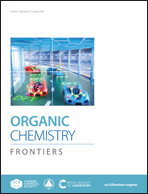Theoretical mechanistic study of metallaphotoredox catalysis: C–N cross-coupling via Ni(ii)-mediated σ-bond metathesis†
Abstract
The C–N cross-coupling reaction has been achieved by photoredox-mediated iridium/nickel dual catalysis, but its mechanism is still controversial in these reactions. A theoretical mechanistic study of the highly chemoselective C–N cross-coupling of pyrrolidine with 4-bromobenzotrifluoride has been performed using density functional theory (DFT) calculations. The oxidation state modulation mechanisms initiated by reductive quenching and oxidative quenching are unfavourable due to the mismatched redox potentials and slow electron transfer rates. In contrast, a radical mechanism merging reductive quenching (IrIII–*IrIII–IrII–IrIII) and nickel catalytic cycles (NiII–NiIII–NiII–NiII) is favourable. It consists of four major processes: exogenous base triggered successive single electron transfer (SET) and hydrogen atom transfer (HAT) to generate a nitrogen-centred radical, radical capture by nickel(II) dibromide, SET to regenerate iridium(III), and the rate-determining σ-bond metathesis to achieve the C–N cross-coupling. Furthermore, the suppression effect caused by α-substitution of pyrrolidine on the reaction is dominantly attributed to the steric effect rather than the electronic effect. Unlike the C–N cross-coupling, the concerted σ-bond metathesis involving nickel(II) is inapplicable for the C–O and C–S cross-couplings due to the high energy barriers. This study is expected to provide new mechanistic insights into metallaphotoredox-catalysed C–N cross-coupling.



 Please wait while we load your content...
Please wait while we load your content...